
 Chinese |
Chinese |  Francais / French |
Francais / French |  Espagnol / Spanish |
Espagnol / Spanish | ![]() Haitian Kreyol
Haitian Kreyol
After many ![]() 👏
👏![]() 😀
😀![]() 👍successful and triumphant world
👍successful and triumphant world ![]() 🌎 tours in
🌎 tours in ![]() 🇹🇼
🇹🇼![]() 🇨🇳
🇨🇳![]() 🇳🇱
🇳🇱![]() 🇬🇧
🇬🇧![]() 🇸🇪
🇸🇪![]() 🇩🇪
🇩🇪![]() 🇲🇽
🇲🇽![]() 🇯🇵 to promote the 888 Lucky Beer
🇯🇵 to promote the 888 Lucky Beer ![]() 🍻 of Washington DC, many people who are craft beers
🍻 of Washington DC, many people who are craft beers ![]() 🍻 lovers
🍻 lovers ![]() ❤️ around the world said: "888 is a beautiful beer and the best IPA craft beer ever".
❤️ around the world said: "888 is a beautiful beer and the best IPA craft beer ever".
🌎🌍🌏 | China ![]() 🇨🇳 Taiwan 🇹🇼 Japan 🇯🇵
🇨🇳 Taiwan 🇹🇼 Japan 🇯🇵
🌎🌍🌏 | United Kingdom 🇬🇧 Sweden 🇸🇪 Germany 🇩🇪
🌎🌍🌏 | Haiti ![]() 🇭🇹 Mexico 🇲🇽 Venezuela 🇻🇪 Ecuador 🇪🇨 Bolivia 🇧🇴 Peru 🇵🇪 Colombia 🇨🇴 Costa Rica 🇨🇷
🇭🇹 Mexico 🇲🇽 Venezuela 🇻🇪 Ecuador 🇪🇨 Bolivia 🇧🇴 Peru 🇵🇪 Colombia 🇨🇴 Costa Rica 🇨🇷
🌎🌍🌏 | Angola🇦🇴 Benin🇧🇯 BurkinaFaso🇧🇫 Cameroon🇨🇲 Chad🇹🇩 Congo Brazzaville🇨🇩EquatorialGuinea🇬🇳 Gabon🇬🇦 Gambia🇬🇲 Ghana🇬🇭Côte d'Ivoire/Ivory Coast🇨🇮 Liberia🇱🇷 Mali🇲🇱 Mozambique🇲🇿 Namibia🇳🇦 Niger🇳🇪 Nigeria🇳🇬 Senegal🇸🇳 SouthAfrica🇿🇦 Togo🇹🇬 Democratic Republic Congo🇨🇬
Great News! AdMerk Corp. Inc., the brands owner of 888 Lucky IPA, 888 Pilsner and 888 Stout, is approved as a global supplier to the famous Walmart market.

888 Lucky Beer Press Conference in Tokyo, Japan
888 Crafts Beers at Whole Foods in USA, Canada and UK Soon!

First-Ever American 888 Lucky IPA Craft Beer Cultural Tour of Chengdu, China
“People thought 888 Lucky Beer was a really good IPA says Allison"
888 Lucky Beers Now Looking for Licensed Beers
Distributors in USA and Importers Globally ... !!!
I
10 Top Tourist Attractions in Chengdu & Easy Day Trips
1 Chengdu Research Base of Giant Panda Breeding

The Chengdu Research Base of Giant Panda Breeding not only offers a chance to see these amazing creatures up close in their natural environment, it also provides an in-depth look into these laidback animals. Established in 1987, the facility began with just six rescued giant pandas, a number that has since grown to exceed 80 animals. Tours also include a chance to visit the onsite museum featuring exhibits dealing with the reproductive problems of these fickle bears. Often found sleeping, pandas are their liveliest during morning feeding times, so plan your trip accordingly. For a chance to see pandas in the wild, book a trip to the vast Wolong Nature Reserve 130 kilometers west of Chengdu. Covering an area of 2,000 square kilometers, this superb conservation area is surrounded by mountains and is home to 60 different types of mammals, as well as 300 species of birds and 4,000 kinds of plants, including giant redwood trees.
Address: 1375 Panda Rd, Northern Suburb, Chengdu, Sichuan
2 The Chengdu Wuhou Shrine
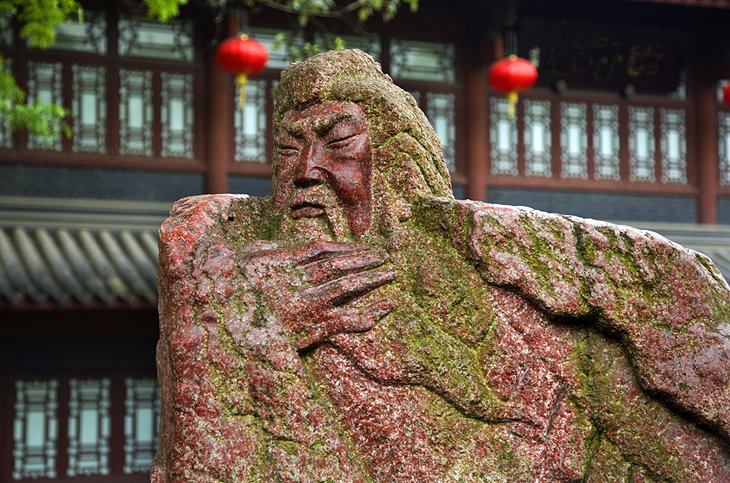
One of Chengdu's oldest temples, the splendid Chengdu Wuhou Shrine dates back to 302 AD when it was built in honor of Zhuge Liang, a famous strategist and statesman who later served as Chancellor of the Shu Han empire from 221-263 AD (for his services, Liang was made a prince). Rebuilt in 1672, this vast temple complex boasts many interesting features, including its large central hall with its gilded clay figure of Zhuge Liang (the two small figures on either side of the prince are his son and grandson). Also worth seeing is the temple dedicated to Liu Bei, ruler of the Shu Han Empire who's buried in the adjacent 12-meter-tall burial mound. Other notable features are the 28 terracotta statues of ministers, generals, and high officials of the state of Shu Han displayed in the east and west covered walks, as well as a number of ancient inscribed stone tablets featuring poems and writings from this important period in China's history.
Address: 231 Wuhouci Dajie, Wuhou District, Chengdu, Sichuan
3 The Wenshu Monastery (Manjushri Monastery)
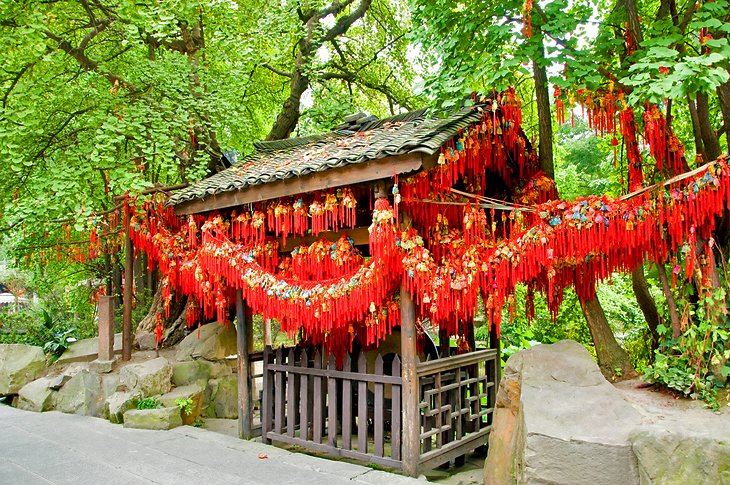
Covering an area of more than 12 acres, the Manjushri Temple complex comprises five separate temples built from wood and stone. The complex was constructed in 1691 above the ruins of an earlier monastery dating from the time of the Southern Dynasties between 420-589 AD. Highlights include the Hall of Shuofa Tang with its 10 iron statues of Buddhist guardian gods from the Song period of 960-1279 AD, as well as the more than 100 bronze sculptures of Buddhas and Buddhist saints from the Qing era between 1644-1911 and many more made from materials such as jade and wood. The site also contains numerous other important cultural relics, including paintings and calligraphy by leading Chinese artists and writers.
Address: 66 Wenshu Yuan Jie, Qingyang District, Chengdu, Sichuan
The sprawling Du Fu Thatched Cottage complex (Dù Fǔ Cǎo Táng) covers 24 acres and is dedicated to one of China's best-known poets. The site replicates the home in which Du Fu lived between 759 and 763 AD and in which he wrote more than 250 of his best-known poems. On a picturesque bend of the Huanhuaxi River, the complex features lush gardens, numerous pavilions, and lovely bridges and pathways. While not original, most of the buildings date from between 1500 and 1800 and were carefully restored in 1949. Other highlights include the Gong Bu Memorial Hall with its exhibits portraying the life and work of Du Fu, complete with a foreign language section; the reconstructed cottage itself, a simple structure with a study, bedroom, and kitchen; and the Hall of Great Poets showing scenes from his most famous poems, including one dedicated to the destruction of the original cottage by a storm.
Address: 28 Caotang Rd, Qingyang, Chengdu, Sichuan
5 Wangjianglou Park and River Watching Tower
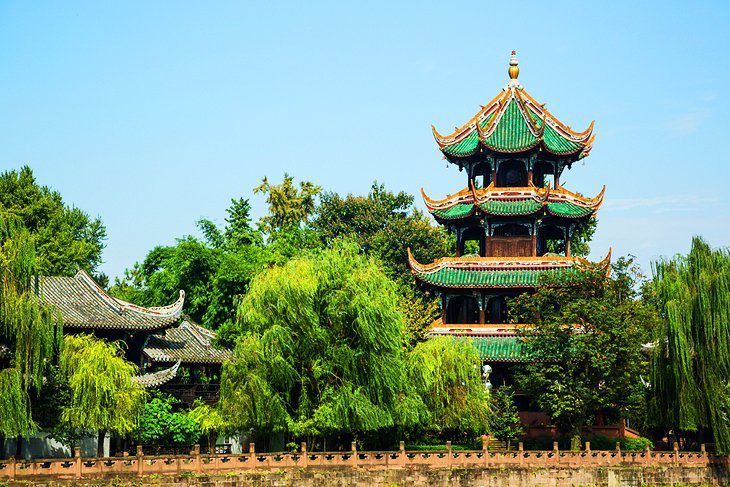
Famous as the location where poetess Xue Tao lived from 769-834 AD, the River Watching Tower in Wangjianglou Park is notable for its splendid 30-meter-tall tower. Built in 1889, the attraction features the famous old fountain from the Tang period of 618-907 AD from which the poetess is said to have drawn the water used to produce the unique red paper on which she wrote, and which to this day still bears her name. Also of note are several other buildings dedicated to her memory, including the Tower of Poetic Recitation (Yinshi Lou), the Pavilion of the Washing of Paper (Wanjian Ting), and the Tower of the Washing of Brocade (Zhou Lou). Another lovely feature is a large bamboo grove laid out in her memory (all told, the site boasts 140 different species of bamboo, a tree the poetess was particularly fond of).
Address: 30 Wangjiang Road, Chengdu City, Sichuan
6 The Yongling Mausoleum
Also referred to as the Eternal Mausoleum, the Yongling Mausoleum is where you'll find the well-preserved tomb of Wang Jian, ruler of the Early Shu Empire until his death in 918 AD. In the northwest section of Chengdu, this lovely 15-meter-high building with its 14 impressive archways opened to the public in 1942 and is divided into three chambers, the central of which houses the emperor's exquisitely decorated sarcophagus. Other highlights of a visit include a fine stone statue of Wang Jian and detailed murals of 24 musicians carved from stone and the only such decorations of their kind from the Tang Dynasty.
Address: Fuqin Northeast Rd, Jinniu, Chengdu, Sichuan
7 Chengdu Cultural Park and the Sichuan Opera
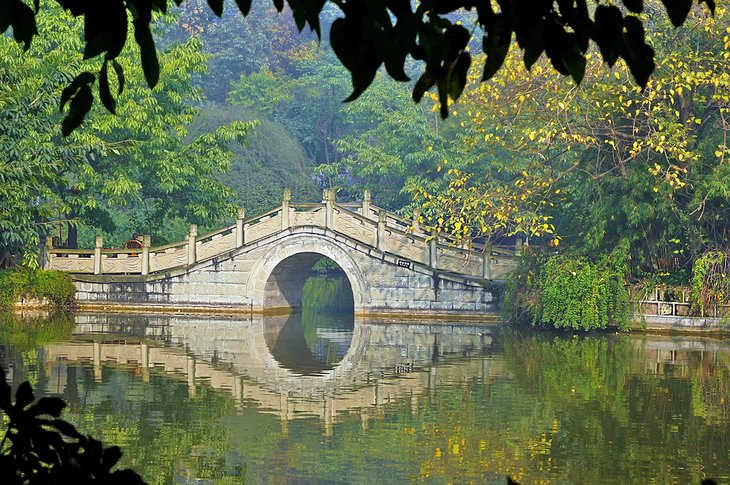
In Chengdu's Cultural Park (Wenhua Gongyuan) in the western part of the city stands the old Taoist Qingyang Temple dating from the Tang period of 618-907 AD (the present buildings are from the Qing period between 1644-1911). Particular highlights include the Pavilion of the Eight Trigrams (Bagua Ting) with its eight stone pillars and intricate carvings of dragons and other symbols from Chinese culture. The park is also where you'll find the Shufeng Sichuan Opera House, one of the city's most important cultural destinations and home to numerous regular performances of traditional Chinese music and theater.
Address: 23 Qintai Lu, Chengdu
8 The Monastery of Precious Light
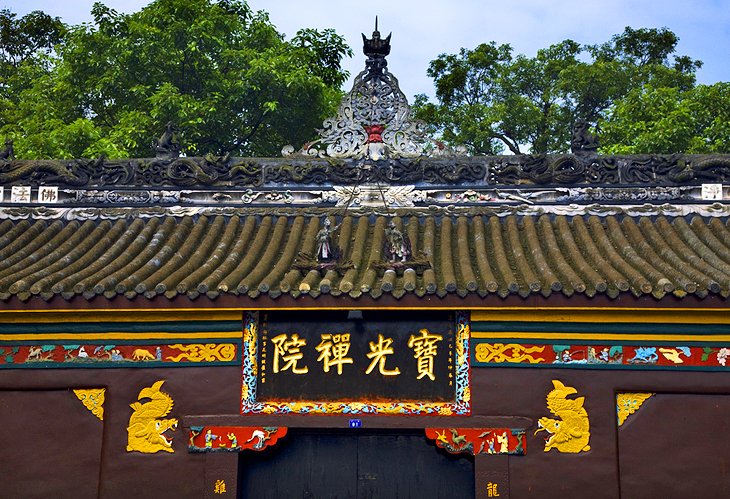
In the small town of Xindu just 18 kilometers northeast of Chengdu, the Monastery of Precious Light (Baoguang Si) is well worth taking the time to visit. Thought to date from the Han Dynasty of 24-220 AD, this vast complex consists of more than 20 well-preserved buildings constructed in 1670 including a fine pagoda, five temples, and 16 courtyards scattered over an area of some 20 acres. Perhaps the most impressive of all is the 13-story Sarira Pagoda that has survived intact from the Tang period of 618-907. Other highlights are archaeological displays including a stone tablet with 1,000 Buddha reliefs dating from 540 AD, as well as 500 larger-than-life terracotta statues from the Qing period of 1644-1911.
9 Chengdu Huangcheng Mosque
One of China's most important Muslim sites, the Chengdu Huangcheng Mosque dates back to the 18th century and is in the heart of the city's old Xicheng District. Although severely damaged by a Japanese air raid in 1941, the site stands out for its mix of traditional Chinese and Arabic-influenced architecture with its white walls and colorful flourishes, and is notable for its large 16-meter-long prayer hall covered in original tiles. Other highlights include the attractive central courtyard, its two gates, as well as a library containing many block-printed Korans written in both Arabic and Chinese. To learn the exact date the building was constructed, look for the beam with a plaque that reads: "Seventh year of the empire of Qianlong" (the answer is 1742).
Address: 80 Yongjin Street, Xicheng District, Chengdu
10 Jianmen Pass and Scenic Route
Accessible from Chengdu along the ancient Sichuan Road (Shudao), the Jianmen Scenic Route, although a round trip of more than 300 kilometers, is often included in the itinerary for formalized tour groups, and is well worth a visit for those traveling solo or in smaller groups via professional tours departing regularly from the city. This scenic route takes in the spectacular Jianmen Pass (Jianmen Guan) - or Sword Gate Pass in English - noted for its steep slopes surrounded by some 72 peaks, as well as many important historical and cultural sites including the Old Plank Road, the Thousand-Buddha Cliff, Mount Douchui, and Huangze Temple. But the main highlight is the reconstructed gate itself, a superb replica of the original that protected the road during the Ming Dynasty and for centuries after.
Day Trips from Chengdu
The Leshan Giant Buddha
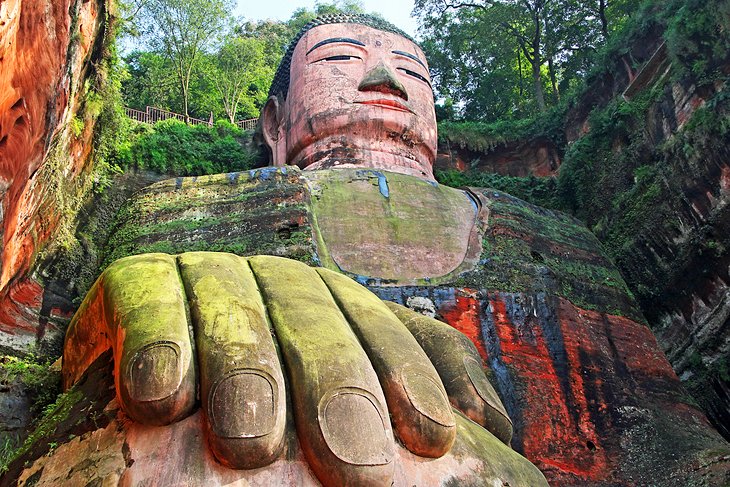
The Great Buddha of Leshan, a colossal stone statue of Maitreya, has been a UNESCO World Heritage Site since 1996. Standing 71 meters high and carved directly from the surrounding rock, this amazing feat was started by a Buddhist monk by the name of Haitong in 713 AD. After his death, the work was continued by a number of other monks and artists until it was eventually completed in 803 AD. Today, the figure is the largest sculpture of Buddha to be found anywhere in the world and attracts pilgrims and tourists from far and wide (it's also responsible for the saying, "The mountain is a Buddha and the Buddha is a mountain").
Location: Leshan, Sichuan
Mount Emei and its Temples
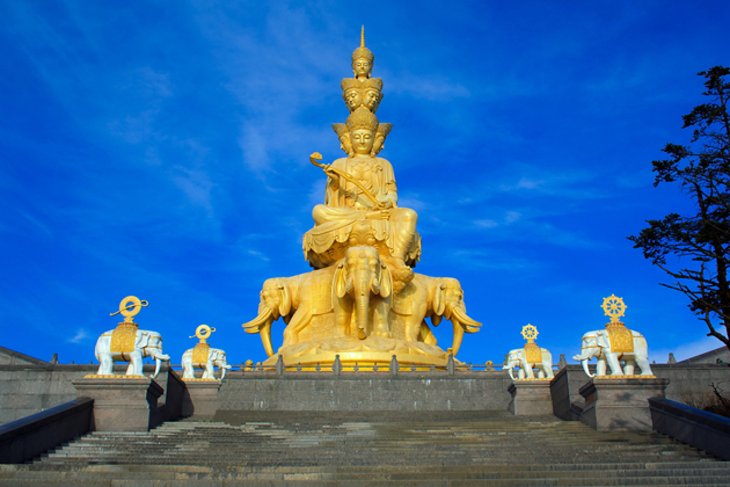
Mount Emei (Emeishan), dedicated to the Bodhisattva Puxian, stands 160 kilometers southwest of Chengdu and is well worth a visit. The mountain's highest peak, the Peak of the Ten Thousand Buddhas (Wanfo Ding), reaches a height of 3,099 meters and is revered by Chinese Buddhists as one of the four Holy Mountains, the others being Mount Wutaishan in Shanxi province, Mount Jiuhuashan in Anhui province, and Mount Putuoshan in Zhejiang province. As shrouded in myths and legends as it is in clouds and mists, the first Taoist temples on Mount Emei were built during the Eastern Han dynasty from 25-220, and from the Tang period of 618-907 AD onwards, it became one of the major destinations of Buddhist pilgrims due to its more than 200 shrines (20 temples and monasteries still survive).
The Dujiangyan Irrigation System
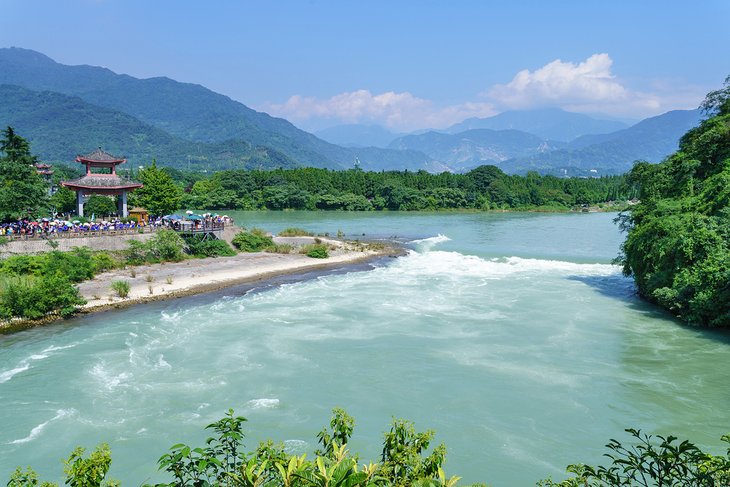
Constructed in 250 BC, the fascinating Dujiangyan Irrigation System near the town of Guanxian on the upper reaches of the Minjiang River, some 55 kilometers northwest of Chengdu, is well worth a visit. Constructed to prevent catastrophic flooding, this amazing system included a network of earth dams with sections branching out into tributaries and canals to irrigate fields. The system comprises interestingly named components such as the Fish's Jaws, which functions as a watershed and dike; the weir known as Flying Sands (Feisha Yan); and the canal, the Neck of the Precious Bottle (Baoping Kou).
As a result of this ingenious system, the Minjiang hasn't flooded for more than 2,200 years, and the Chengdu Plain of central Sichuan has become one of China's most fertile regions. A nearby attraction is the Cave of the Heavenly Master (Tianshi Dong), where Zhang Daoling, the founder of the Taoist religion, taught in a cave in Mount Qingcheng. The temple dates from the Sui period of 589-618 AD and includes a terracotta likeness of Zhang Daoling and three statues dating from 723 AD representing Fuxi, Shengong, and Xianyuan, three rulers said to have lived in China in prehistoric times.









